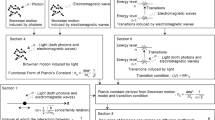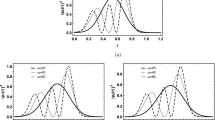Abstract
In this work, we study the dynamics of quantum correlation for two uniformly accelerated atoms immersed in a bath of fluctuating massless scalar field with a perfectly reflecting plane boundary in the Minkowski vacuum. Firstly, the master equation that governs the system evolution is derived. Then we discuss the generation, revival and decay of quantum correlation for initial zero-correlation state and initial entangled state in various conditions and models. We contrast the behaviors of quantum correlation of accelerated atoms with that of static atoms in a thermal bath at the corresponding Unruh temperature and also make a comparison between behaviors of quantum correlation and entanglement behaviors. We find that behaviors of quantum correlation of uniformly accelerated atoms present some features distinct from that of static atoms immersed in a thermal bath, and behaviors of quantum correlation are more robust than that of entanglement.




Similar content being viewed by others
References
Niset, J., Cerf, N.J.: Multipartite nonlocality without entanglement in many dimensions. Phys. Rev. A 74, 052103 (2006)
Datta, A., Vidal, G.: Role of entanglement and correlations in mixed-state quantum computation. Phys. Rev. A 75, 042310 (2007)
Datta, A., Shaji, A., Caves, C.M.: Quantum discord and the power of one qubit. Phys. Rev. Lett. 100, 050502 (2008)
Lanyon, B.P., Barbieri, M., Almeida, M.P., White, A.G.: Experimental quantum computing without entanglement. Phys. Rev. Lett. 101, 200501 (2008)
Dakić, B., et al.: Quantum discord as resource for remote state preparation. Nat. Phys. 8, 666 (2012)
Modi, K., Brodutch, A., Cable, H., Paterek, T., Vedral, V.: The classical-quantum boundary for correlations: discord and related measures. Rev. Mod. Phys. 84, 1655 (2012)
Pirandola, S.: Quantum discord as a resource for quantum cryptography. Sci. Rep. 4, 6956 (2014)
Ollivier, H., Zurek, W.H.: Quantum discord: a measure of the quantumness of correlations. Phys. Rev. Lett. 88, 017901 (2001)
Henderson, L., Vedral, V.: Classical, quantum and total correlations. J. Phys. A Math. Gen. 34, 6899 (2001)
Dakić, B., Vedral, V., Brukner, Č.: Necessary and sufficient condition for nonzero quantum discord. Phys. Rev. Lett. 105, 190502 (2010)
Luo, S., Fu, S.: Geometric measure of quantum discord. Phys. Rev. A 82, 034302 (2010)
Huang, Z.M., Qiu, D.W.: Geometric quantum discord under noisy environment. Quantum Inf. Process. 15, 1979 (2016)
Debarba, T., Maciel, T.O., Vianna, R.O.: Witnessed entanglement and the geometric measure of quantum discord. Phys. Rev. A 86, 024302 (2012)
Paula, F.M., de Oliveira, T.R., Sarandy, M.S.: Geometric quantum discord through the Schatten 1-norm. Phys. Rev. A 87, 064101 (2013)
Huang, Z.M., Qiu, D.W., Mateus, P.: Geometry and dynamics of one-norm geometric quantum discord. Quantum Inf. Process. 15, 301 (2016)
Luo, S., Fu, S.: Measurement-induced nonlocality. Phys. Rev. Lett. 106, 120401 (2011)
Hu, M.L., Fan, H.: Measurement-induced nonlocality based on the trace norm. New J. Phys. 17, 033004 (2015)
Qiu, L., Liu, Z.: Hierarchy, factorization law of two measurement-induced nonlocalities and their performances in quantum phase transition. Quantum Inf. Process. 15, 2053 (2016)
Unruh, W.G.: Notes on black-hole evaporation. Phys. Rev. D 14, 870 (1976)
Benatti, F., Floreanini, R.: Entanglement generation in uniformly accelerating atoms: reexamination of the Unruh effect. Phys. Rev. A 70, 012112 (2004)
Zhang, J.L., Yu, H.W.: Entanglement generation in atoms immersed in a thermal bath of external quantum scalar fields with a boundary. Phys. Rev. A 75, 012101 (2007)
Zhang, J.L., Yu, H.W.: Unruh effect and entanglement generation for accelerated atoms near a reflecting boundary. Phys. Rev. D 75, 104014 (2005)
Hu, J.W., Yu, H.W.: Entanglement dynamics for uniformly accelerated two-level atoms. Phys. Rev. A 91, 012327 (2015)
Yang, Y.Q., Hu, J.W., Yu, H.W.: Entanglement dynamics for uniformly accelerated two-level atoms coupled with electromagnetic vacuum fluctuations. Phys. Rev. A 94, 032337 (2016)
Salton, G., Mann, R.B., Menicucci, N.C.: Acceleration-assisted entanglement harvesting and rangefinding. arXiv:1408.1395 (2015)
Huang, Z.M.: Dynamics of quantum correlation of atoms immersed in a thermal quantum scalar fields with a boundary. Quantum Inf. Process. 17, 221 (2018)
Casimir, H.B.G.: On the attraction between two perfectly conducting plates. Proc. K. Ned. Akad. Wet. 51, 793 (1948)
Yu, H., Wu, P.X.: Quantum fluctuations of the light cone in four-dimensional spacetime with parallel plane boundaries. Phys. Rev. D 68, 084019 (2003)
Ali, M., Rau, A.R.P., Alber, G.: Quantum discord for two-qubit X states. Phys. Rev. A 81, 042105 (2010)
Chen, Q., Zhang, C., Yu, X., Yi, X.X., Oh, C.H.: Quantum discord of two-qubit X states. Phys. Rev. A 84, 042313 (2011)
Li, B., Wang, Z.X., Fei, S.M.: Quantum discord and geometry for a class of two-qubit states. Phys. Rev. A 83, 022321 (2011)
Huang, Z.M., Situ, H.Z., Zhang, C.: Quantum coherence and correlation in spin models with Dzyaloshinskii-Moriya interaction. Int. J. Theor. Phys. 56, 2178 (2017)
Ma, F.W., Liu, S.X., Kong, X.M.: Quantum entanglement and quantum phase transition in the XY model with staggered Dzyaloshinskii-Moriya interaction. Phys. Rev. A 84, 042302 (2011)
Martínez, E.M., Smith, A.R.H., Terno, D.R.: Spacetime structure and vacuum entanglement. Phys. Rev. D 93, 044001 (2016)
Huang, Z.M.: Dynamics of quantum correlation and coherence in de Sitter universe. Quantum Inf. Process. 16, 207 (2017)
Huang, Z.M., Tian, Z.H.: Dynamics of quantum entanglement in de Sitter spacetime and thermal Minkowski spacetime. Nucl. Phys. B 923, 458 (2017)
Huang, Z.M., Tian, Z.H.: Dynamics of quantum correlation in de Sitter spacetime. J. Phys. Soc. Jpn. 86, 094003 (2017)
Huang, Z.M., Zhang, C., Zhang, W., Zhao, L.H.: Equivalence of quantum resource measures for X states. Int. J. Theor. Phys. 56, 3615 (2017)
Huang, Z.M., Situ, H.Z.: Dynamics of quantum correlation and coherence for two atoms coupled with a bath of fluctuating massless scalar field. Ann. Phys. 377, 484 (2017)
Huang, Z.M., Situ, H.Z.: Quantum coherence behaviors of fermionic system in non-inertial frame. Quantum Inf. Process. 17, 95 (2018)
Huang, Z.M., Ye, Y.Y., Luo, D.R.: Simultaneous dense coding affected by fluctuating massless scalar field. Quantum Inf. Process. 17, 101 (2018)
Huang, Z.M.: Quantum-memory-assisted entropic uncertainty in spin models with Dzyaloshinskii-Moriya interaction. Laser Phys. Lett. 15, 025203 (2018)
Huang, Z.M.: Dynamics of entropic uncertainty for atoms immersed in thermal fluctuating massless scalar field. Quantum Inf. Process 17, 73 (2018)
Huang, Z.M.: Protecting quantum Fisher information in curved space-time. Eur. Phys. J. Plus 133, 101 (2018)
Huang, Z.M., Situ, H.Z.: Exploration of entropic uncertainty relation for two accelerating atoms immersed in a bath of electromagnetic field. Quantum Inf. Process. 18, 38 (2019)
Sanchez, N.: Comments on quantum detection and the anisotropy of thermal radiation by accelerated observers. Phys. Lett. 112A, 133 (1985)
Kolbenstvedt, H.: Anisotropy of thermal radiation by accelerated detectors; an aberration effect. Phys. Lett. A 122, 292 (1987)
Crispino, L.C.B., Higuchi, A., Matsas, G.E.A.: The Unruh effect and its applications. Rev. Mod. Phys. 80, 787 (2008)
Albash, T., Boixo, S., Lidar, D.A., Zanardi, P.: Quantum adiabatic Markovian master equations. New J. Phys. 14, 123016 (2012)
Breuer, H.-P., Petruccione, F.: The Theory of Open Quantum Systems. Oxford University Press, Oxford (2002)
Gorini, V., Kossakowski, A., Surdarshan, E.C.G.: Completely positive dynamical semigroups of N-level systems. J. Math. Phys. 17, 821 (1976)
Lindblad, G.: On the generators of quantum dynamical semigroups. Commun. Math. Phys. 48, 119 (1976)
Birrell, N.D., Davies, P.C.W.: Quantum fields Theory in Curved Space. Cambridge University Press, Cambridge (1982)
Wootters, W.K.: Entanglement of formation of an arbitrary state of two qubits. Phys. Rev. Lett. 80, 2245 (1998)
Acknowledgements
This work is supported by the National Natural Science Foundation (61871205), the Innovation Project of Department of Education of Guangdong Province of China (2017KTSCX180), the Jiangmen Science and Technology Plan Project for Basic and Theoretical Research (2018JC01010) and the Guangdong Philosophy and Social Science Planning Project (GD15XGL55).
Author information
Authors and Affiliations
Corresponding author
Additional information
Publisher's Note
Springer Nature remains neutral with regard to jurisdictional claims in published maps and institutional affiliations.
Appendix: some relevant results of Ref. [26]
Appendix: some relevant results of Ref. [26]
TMIN as function of \(\omega t\) for two atoms in the ground state \(|00\rangle \) when two-atom distance \(L\rightarrow 0\) for a different temperatures with \(\omega z=1\) and b different distances from the boundary with \(T/\omega =\frac{1}{2}\). (corresponding to Fig. 2 of Ref. [26])
TMIN as function of \(\omega t\) for two atoms in the ground state \(|00\rangle \) when two atoms are placed very far from the boundary (\(z\rightarrow \infty \)) for a different temperatures with \(L\omega =\frac{1}{2}\) and b different two-atom distances with \(T/\omega =\frac{3}{10}\). (corresponding to Fig. 3 of Ref. [26])
TMIN as function of \(\omega t\) for two atoms in the ground state \(|00\rangle \) for a different temperatures with \(L\omega =1\) and \(z\omega =2\), b different two-atom distances with \(T/\omega =\frac{1}{2}\) and \(z\omega =1\) and c different distances from boundary with \(T/\omega =\frac{1}{2}\) and \(L\omega =\frac{1}{2}\). (corresponding to Fig. 6 of Ref. [26])
a TMIN as function of \(\omega t\) for the initial Werner state \(p|\phi _1\rangle \langle \phi _1|+(1-p)\frac{I}{4}\) case when \(p=\frac{1}{2}\) for different temperatures with \(L\omega =\frac{1}{2}\) and \(z\omega =1\). b TMIN as function of \(\omega t\) for different two-atom distances with \(T/\omega =1\) and \(z\omega =1\). c TMIN as function of \(\omega t\) for different distances from boundary with \(T/\omega =1\) and \(\omega L=1\). (corresponding to Fig. 7 of Ref. [26])
In Ref. [26], we study the behaviors of quantum correlation for two atoms immersed in a thermal bath of quantum scalar fields in the presence of a perfectly reflecting plane boundary. In this paper, we obtain the relative coefficients
In the equilibrium state, we get
When two atoms are placed very close to the reflecting boundary (\(z\rightarrow 0\)), it is found that \(A_1=A_2=B_1=B_2=0\). There is no generated quantum correlation.
When temperature \(T\rightarrow 0\), we get
Rights and permissions
About this article
Cite this article
Huang, Z. Behaviors of quantum correlation for accelerated atoms coupled with a fluctuating massless scalar field with a perfectly reflecting boundary. Quantum Inf Process 18, 187 (2019). https://doi.org/10.1007/s11128-019-2310-x
Received:
Accepted:
Published:
DOI: https://doi.org/10.1007/s11128-019-2310-x








